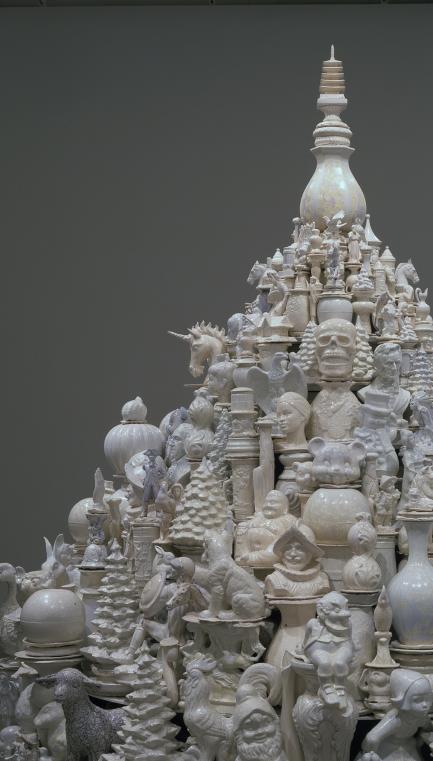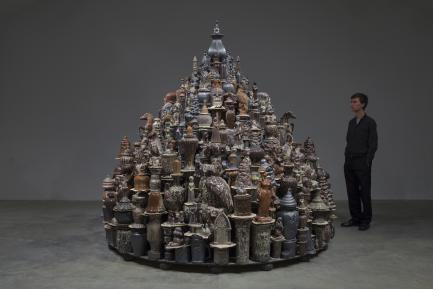“Chinamania” Installation by Artist Walter McConnell Features a Profusion of Porcelain at the Smithsonian’s Sackler Gallery
American sculptor Walter McConnell explores the West’s near-fanatical fascination with blue-and-white Chinese porcelain from the 1870s through today in the installation “Chinamania.” On view at the Arthur M. Sackler Gallery from July 9 through June 4, 2017, it will complement “Peacock Room REMIX: Darren Waterson’s Filthy Lucre,” currently on view.
“Chinamania,”—the third installment of exhibitions running concurrently with Waterson’s “Peacock Room REMIX”—includes more than 50 blue-and-white porcelains from China’s Kangxi period (1661–1722)—similar to those originally displayed in James McNeill Whistler’s Peacock Room. McConnell designed the dramatically lit display of blue-and-whites and a pendant piece created from 3-D scans of the porcelain originals. The exhibition also features two monumental ceramic stupas, each composed of more than 800 individual porcelain figures from McConnell’s series “A Theory of Everything.”
“Filthy Lucre,” Waterston’s room-sized installation inspired by Whistler’s Peacock Room—designed to showcase its original owner’s vast porcelain collection—holds scores of vessels inspired by the collection of museum founder Charles Lang Freer. Arranged on the buckling shelves of the disheveled interior, the oozing, misshapen ceramics convey a sense of unsustainable luxury and excess that is also a key theme of McConnell’s work.
During the 17th century, many aristocratic palaces and country houses throughout Europe boasted a porcelain chamber, a room specifically built for large displays of ceramics. Later, in the Victorian era, the craze trickled down to the middle class, for whom blue-and-white ceramics became a sign of status and taste. These cultural commentators of the time both embraced and poked fun at the porcelain craze. Illustrator George du Maurier parodied the fad in a series of cartoons for Punch Magazine that documented what he mockingly called “Chinamania.”
McConnell became interested in Chinese porcelain and its place in Western culture in 2002 when he visited Jingdezhen, China, a major site of ceramics production and export since the 14th century. For “Chinamania,” McConnell examines the aesthetic and cultural meanings of replication, consumerism and transnational encounters both commercial and artistic.
“By juxtaposing historical export wares with his own monuments of ceramic excess, McConnell reminds us that a culture of aspirational shopping and ever-cheaper knock-offs has a long history,” said Lee Glazer, associate curator of American art. “His work also reminds us that meticulous craftsmanship and singular artistic vision can overcome the banality of mass production and conspicuous consumption.”
About the Artist
McConnell is a professor of ceramic art at Alfred University’s School of Art and Design. He is well known for his installations of moist clay and towering assemblages of cast porcelain. He received his Bachelors of Fine Arts from the University of Connecticut in 1974 and his Masters of Fine Arts in ceramic art from Alfred University in New York State in 1986. He has received grants from the Joan Mitchell Foundation, the Louis Comfort Tiffany Foundation, the New York Foundation for the Arts and the Constance Saltonstall Foundation. The Denver Art Museum, Philadelphia Museum of Art, MASS MoCA in North Adams, the Daum Museum of Contemporary Art in Missouri, the University of Colorado Art Museum in Boulder and SOFA [Sculpture Objects and Functional Art], New York, have shown his installations of moist clay and towering assemblages of cast porcelain. He has exhibited internationally in Sweden, the Netherlands, Taiwan, China and Korea. Essays and reviews on McConnell’s work have appeared in Sculpture Magazine, World Sculpture News, New Art Examiner, Ceramics: Art and Perception, The New York Times, The Washington Post and Ceramics Monthly.
About the Freer and Sackler Galleries
The Smithsonian’s Freer Gallery of Art and Arthur M. Sackler Gallery, located on the National Mall in Washington, D.C., serves as both a crossroads and a meeting point, encouraging the exploration and understanding of the arts of Asia and the cultures that produced them, from the Pacific to southeastern Europe and Africa. It holds one of the most important and comprehensive collections of Asian art in the world, featuring more than 40,000 objects from the Neolithic age to the present, including the Freer’s collection of American art from the late 19th century aesthetic movement, most notably works by American artist James McNeill Whistler. The Freer, which will be closed during the exhibition, is scheduled to reopen in spring 2017 with modernized technology and infrastructure, and refreshed and reinterpreted gallery spaces.
# # #
SI-351-2016
Juliette Pasquini
202-655-9403



